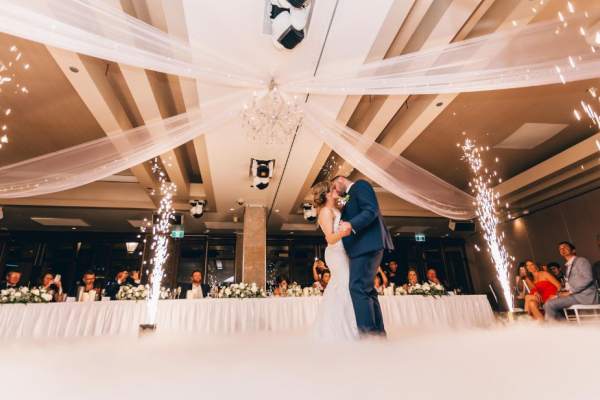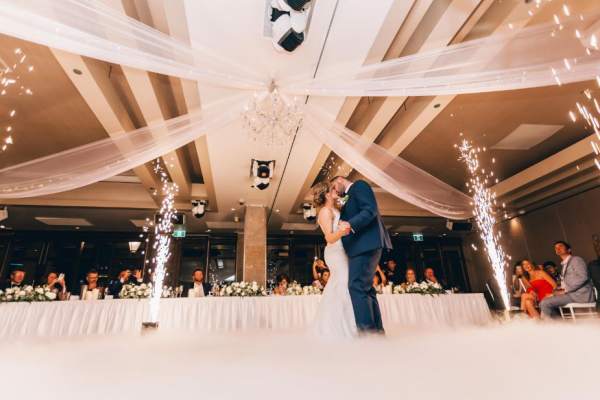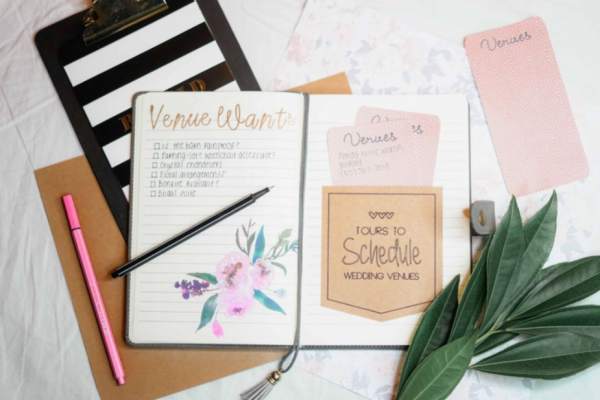Mastering Wedding Etiquette: The Art of Reception Seating Arrangement
Last Updated on October 12, 2023 by Project Party
One of the most critical aspects of planning a wedding is getting the reception seating arrangement just right. The way your guests are seated can significantly influence the overall vibe and interaction at your event. Here’s an easy-to-follow guide to help you master your wedding reception seating arrangement.
Setting the Ground Rules: Traditionally, the bride sits to the groom’s right, with the best man on her left and the maid of honour to the groom’s right. However, these rules aren’t set in stone. It’s your special day, and the seating arrangement should reflect your personal preferences and ensure the comfort of your guests:
- Deciding on Table Shapes: The shape of your tables can greatly impact the dynamics of your reception. Standard options include round, rectangle, oval, and square. Each shape fosters a different kind of interaction among guests, so consider what kind of ambience you want to create when making this decision.
- Prioritizing Family Members: Family members, especially parents and grandparents, should be given prime seats at your reception. Typically, they are seated at the table closest to the newlyweds. If space allows, all grandparents should be seated at the parents’ table. If not, ensure their table is close by and offers a clear view of the festivities.
- Crafting a Seating Chart: Creating a seating chart may seem overwhelming, but it doesn’t have to be. Start with a floor plan of your venue, marking out spaces for essential elements like music and food stations. Then, start placing your guests, beginning with the head table and working your way outwards.
- Utilizing Helpful Tools: Numerous online tools can make planning your reception seating arrangement a breeze. These tools allow you to assign individual seats within each table, ensuring everyone has a place and nobody gets overlooked.
- Seeking Inspiration: Don’t hesitate to let your creativity shine when planning your reception seating arrangement. Look for inspiration in wedding magazines, on Pinterest, or from other weddings you’ve attended. Experiment with different themes, decorations, and layouts to make your reception truly unique.

In conclusion, your wedding reception seating arrangement is more than just a logistical detail—it’s a crucial element that contributes to the overall success of your big day. By keeping these tips in mind, you can ensure an unforgettable experience for all your guests. With that in mind, here are the key table requirements to consider when creating your seating chart:
1. The Head Table: The Couple and the Bridal Party
The reception seating arrangement, a crucial aspect of the wedding planning, is primarily embodied in the head table. Often the centrepiece of the reception room, the head table is traditionally reserved for the couple and their bridal party. This table, a key component of the reception seating arrangement, is usually placed in a prominent position, facing all other tables, symbolizing the couple’s central role in the celebration.
Traditionally, the couple sits in the middle of this key element of the reception seating arrangement, with the groom seated to the bride’s right. Next to the groom is the maid of honour, followed by the bridesmaids. The bride has the best man seated to her left, followed by the groomsmen. This traditional reception seating arrangement ensures that the couple remains the focal point, with their closest friends and allies surrounding them.
However, modern weddings often feature a ‘sweetheart table’ which seats only the couple. This setup allows the bridal party to join other guests, while the couple enjoys some moments of togetherness amidst the larger celebration. It also gives the couple some much-needed privacy during the meal, offering a break from the constant attention.

2. Parents’ Tables: Honoring the Pillars of Support
The parents’ tables are a significant part of the seating arrangement. They usually include both sets of parents and any immediate family members not part of the bridal party. These tables should be placed near the head table to ensure the parents feel included in the main events of the celebration. The position of the parents’ tables is a subtle acknowledgement of their significant role and contributions to the couple’s lives. It provides them with a clear view of the proceedings, allowing them to participate in the joy and excitement of the occasion fully.
If the parents are divorced or separated, it may be more comfortable for them to host separate tables. Each table can include their respective families or close friends, ensuring everyone feels at ease. Both tables should hold prime positions within the room to avoid feelings of favouritism. This arrangement acknowledges the complexity of modern family structures and ensures that all parents feel equally honoured on this special day.
3. Grandparents’ Seating: Acknowledging the Elders
Grandparents indeed hold a special place in our hearts and wedding celebrations, making their inclusion in the reception seating arrangement a priority. If present, they are typically seated at the parents’ table, as part of the traditional reception seating arrangement. However, if there are step-parents or if the parents’ table is overcrowded, consider modifying the reception seating arrangement by giving the grandparents their own table. This separate table should be located nearby so they don’t miss out on any of the festivities. It also allows them to sit comfortably and engage in conversations without feeling overwhelmed by the noise and bustle.
When devising your reception seating arrangement, make sure to consider their mobility needs when choosing the location of this table. Your thoughtful reception seating arrangement can ensure that they feel considered and comfortable during this joyous occasion.
Grandparents often bring a unique warmth and wisdom to these occasions. Their presence is a link to the family’s past, a symbol of continuity and tradition. By giving them a special place in your seating arrangement, you show your respect and appreciation for their role in your life.
4. Friends and Extended Family: Encouraging Camaraderie
Friends and extended family make up the fabric of our social lives, and their presence adds vibrancy and joy to the wedding celebration. When seating these guests, it’s best to group them based on their relationships or common interests. This encourages conversation and helps everyone feel more comfortable. For instance, you could seat all your cousins together, creating a mini reunion within the wedding. College friends, who might not have seen each other for a while, can catch up and reminisce about old times. Neighbours or family friends who know each other well can share a table, providing a familiar and relaxing environment.
This arrangement also allows these guests to connect with others they might not see regularly. It creates opportunities for networking, storytelling, and the deepening of relationships. By thoughtfully grouping your guests, you can facilitate a more enjoyable and memorable experience for them.
5. Colleagues and Professional Contacts: Mixing Business with Pleasure
Work colleagues or professional contacts are indeed an integral part of our lives. They share our daily routines, challenges, and successes. Including them in your wedding and thoughtfully considering their place in the reception seating arrangement is a great way to acknowledge this relationship. These guests generally appreciate being seated together as part of the reception seating arrangement. Familiar faces can help them relax and enjoy the celebration away from the work environment. Incorporating this into your reception seating arrangement can also provide a unique opportunity for team bonding outside the office setting. Thus, a well-planned reception seating arrangement can enhance their experience and make them feel included and comfortable during your special day.
When arranging these tables, consider the dynamics of your workplace. Try to group colleagues who get along well together and avoid any potential for tension or discomfort. If you have clients or business partners attending, consider seating them with people they’ll find interesting or beneficial. This can turn your wedding into an opportunity for strengthening professional relationships.
6. Children’s Table: Keeping the Young Ones Engaged
If your wedding includes several children, consider setting up a separate children’s table. This setup not only keeps the young ones together but also allows them to enjoy the event in their way. A children’s table can be made fun and engaging with activities, games, or colouring books. You could even hire a professional babysitter or entertainer to keep them occupied during the ceremony and reception. This arrangement allows the parents to enjoy the event while knowing their children are safe and having fun.
Ensure this table is within sight of their parents for easy supervision. Also, remember to serve kid-friendly food at this table and use unbreakable dishware to prevent any accidents.
Including children in your wedding can add a wonderful sense of joy and spontaneity to the occasion. By providing a special place for them in your seating plan, you ensure they feel included and valued.
7. Singles’ Table: Facilitating New Connections
If you have several single friends attending, incorporating a singles’ table into your reception seating arrangement may be an idea worth considering. This can be a fun way for them to meet new people and possibly make connections, as part of the overall dynamics of the reception seating arrangement.
However, it’s important to be sensitive to your guests’ comfort levels with this arrangement. Not all singles appreciate being grouped together in your reception seating arrangement, and some might prefer to sit with couples they know well. As such, while planning your reception seating arrangement, be sure to consider individual preferences and comfort levels to ensure everyone has an enjoyable experience at your celebration.
If you do opt for a singles’ table, try to group people with similar interests or backgrounds. Consider age, profession, hobbies, and other factors to increase the likelihood of meaningful connections.
Remember, the main goal is to ensure that everyone feels comfortable and enjoys the celebration. If you’re unsure about a singles’ table, it might be best to discuss it with your guests beforehand or stick to more traditional seating arrangements.

8. Elderly Guests: Prioritizing Comfort
Other elderly guests, in addition to grandparents, may require special consideration when planning seating arrangements. Tables close to amenities but away from speakers can be a good choice. Comfortable seating and easy access are key considerations for these valued guests. It’s important to ensure that they have a clear view of the proceedings without straining their eyes or ears. Consider the acoustics of the venue and try to shield them from loud music or noise.
Additionally, remember that they might need to leave earlier than other guests. Make sure their path to the exit is clear and easily navigable, avoiding steps or obstacles. Their comfort and enjoyment should be a priority in your planning.
9. Special Needs Guests: Ensuring Accessibility
Guests with special needs should be seated in areas that are easily accessible and near facilities they might need. If necessary, reserve space for wheelchairs or service animals. When planning seating arrangements, take into account any visual or auditory impairments, dietary restrictions, or other specific needs. It’s crucial to communicate with these guests before the event to understand their needs and preferences.
By thoughtfully considering these factors, you can ensure that every guest feels welcomed, comfortable, and able to fully enjoy your special day.
The Ultimate 5-Step Guide to Your Wedding Reception Seating Arrangement
With an idea of your reception seating arrangement requirements in mind, the next step is to plan it out. Creating an effective seating plan not only ensures your guests have a memorable time but also contributes to the smooth running of your reception. Here’s a simple five-step process to help you navigate this task:
- Compile Your Guest List: The foundation of your reception seating arrangement lies in knowing who will be sharing your special day with you. Finalise your guest list to determine the number and size of tables you’ll need for the reception.
- Familiarise Yourself with the Venue Layout: Understanding your venue’s layout is crucial when planning your reception seating arrangement. Take into account the location of key elements such as the dance floor, food stations, and restrooms, as they will influence the comfort and convenience of your guests.
- Group Guests Strategically: As you start to envision your reception seating arrangement, group your guests according to their relationships or common interests. This could mean seating families together, or clustering friends who share common bonds. For guests who may not know many others, try to seat them with people who have similar interests or personalities
- Assign Tables, Not Seats: A golden rule for a hassle-free reception seating arrangement is to assign guests to tables, not specific seats. This approach offers your guests some freedom to choose who they sit next to at their assigned table, fostering a more relaxed atmosphere.
- Craft a Clear Seating Chart and Display it Prominently: With everyone assigned to a table, prepare a clear and easy-to-read seating chart. Display this chart prominently at the entrance to the dining area, so guests can effortlessly locate their tables.
Remember, the primary goal of your reception seating arrangement should be to make your guests feel comfortable and encourage interaction. By following these steps, you’ll be well on your way to creating a well-organised and enjoyable wedding reception.
Mastering Your Wedding: How to Plan the Perfect Reception Seating Arrangement
In conclusion, the effectiveness of your wedding seating arrangement hinges upon careful consideration of the unique needs and preferences of each guest. The ultimate aim is to foster an atmosphere of inclusivity and enjoyment, wherein every attendee feels valued, comfortable, and engaged. By prioritising accessibility, acoustics, and the proximity of amenities, you can ensure a memorable experience for all. Remember, it’s your wedding, and your personal touch will create the unique ambience that will make it unforgettable. Plan with empathy and care, and your special day will be a joyous celebration enjoyed by every guest. Happy wedding planning! ƒ End of Section.
Related Posts
The Best Wedding Reception Songs for Each Part of the Wedding Night
Congratulations on your upcoming wedding! As you dive into the intricate details of wedding planning, one crucial element that should not be…
July 20, 2020
The Typical Wedding Reception Order of Events: What to Expect
If you're knee-deep in the process of planning your wedding and it's starting to feel like a daunting task, take a deep breath. You've found the…
October 11, 2021
The Wedding Checklist: 16 Things to Do in the Week of Your Wedding
As the clock ticks down to your big day, the week of your wedding can feel like a whirlwind of emotions and to-do lists. The anticipation of the…
September 13, 2021


